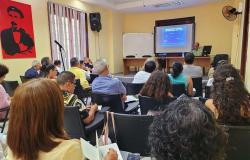15:58
The climatic stability that predominated during the last week in the central north of Santa Fe allowed progress in the tasks of harvesting first class soybeans, which shortly after completion shows the return of yields considered normal for the region, after the hard blow suffered by production in the previous season due to the drought.
In general, in the 12 departments monitored by the Agricultural Estimates System (SEA), threshing was 90% completed and remains 10% behind last year. However, in the southern districts the work has already concluded and in the center it reached 97%, while in the north there is a significant delay for the time since the collection reached 74%. A year ago, the work was completed throughout the region.
The good news is the yields, especially when compared to those of the previous cycle, when the average for the entire region was 17.3qq/ha.
In the southern sector (San Jerónimo and San Martín departments), the averages range between a minimum of 28 to 30 qq/ha and a maximum of 40 to 45 qq/ha, with specific plots where 52 qq/ha were reached. In 2023, the lowest had been 16 – 18 qq/ha with maximums of 25 – 28 qq/ha and specific plots of 30 to 32 qq/ha.
In the center (San Cristóbal, San Justo, Castellanos, Las Colonias and La Capital) yields are between 18 – 20 – 24 qq/ha and 38 to 42 qq/ha, with cases of 50 qq/ha. Last year they were between 10 – 12 qq/ha up to 22 – 28 qq/ha, with specific batches of 34 to 36 qq/ha.
While in the north (Nueve de Julio, Vera, General Obligado and San Javier) they range from 10 – 12 – 14 qq/ha to a maximum of 17 to 22 qq/ha, with maximum marks of 28 qq/ha. A year ago they ranged between 10 – 12 qq/ha to 17 – 19 qq/ha.
The report released by the Santa Fe Stock Exchange also highlights that “it was the first week in which the early soybean harvest process was fully developed (first class), since it began at the end of March. “. Since then, work had suffered permanent interruptions as a result of environmental conditions.
The second one
On the other hand, the harvest process of late (second) soybeans continued at a good pace, favored by the climatic characteristics and the availability or not, of equipment or harvesters. However, the degree of progress is 40%, with a delay of 10% compared to the last campaign.
 See alsoThe field smiles with the first frost: it would help with the harvest and control the leafhopper
See alsoThe field smiles with the first frost: it would help with the harvest and control the leafhopper So far, yields in the southern sector range from 24 to 26 qq/ha, with maximums of 35 to 38 qq/ha and specific plots of 42 qq/ha.
In the central sector, the minimum average yields obtained varied from 12 – 15 – 18 qq/ha, with maximums of 28 to 32 qq/ha and in specific plots 38 qq/ha were recorded.
And in the northern sector, the minimums are 08 – 10 – 12 qq/ha, with maximums of 15 to 18 qq/ha and in specific lots 25 qq/ha were recorded.








